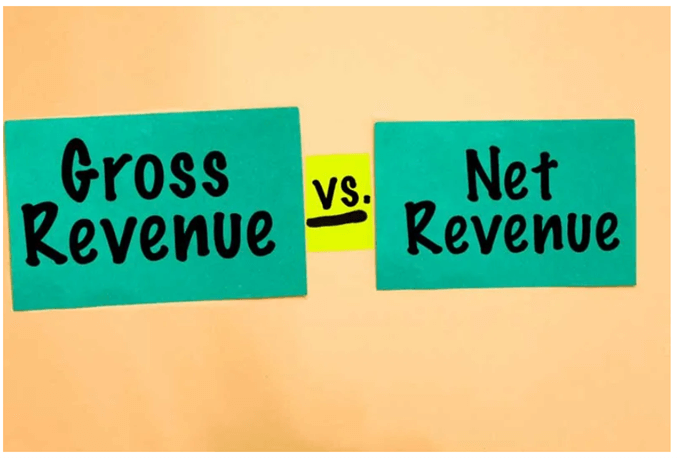When evaluating the financial potential of a new business, it is important for both founders and investors to understand key metrics. These metrics provide valuable insights into the business’s performance.
Among these metrics, gross revenue and net revenue are two important figures that can help paint a comprehensive picture. Although the terms may seem similar, they represent distinct aspects of the business’s potential, and it is essential to grasp their calculations and interpretations.

Understanding the difference between gross revenue and net revenue is important as it allows for a more comprehensive evaluation of a company’s overall performance. Relying solely on gross revenue, which represents only a portion of the picture, can be misleading when creating a budget.
On the other hand, net revenue provides a more holistic perspective, but its interpretation becomes challenging without considering the context provided by gross revenue. By grasping the relationship between these two metrics, a clearer understanding of the business’s financial potential can be obtained.
Gross Revenue vs Net Revenue: The Difference

The difference between gross revenue and net revenue is determined by the expenses incurred by a company. These expenses encompass various elements, such as the direct costs of goods sold, variable expenses, and fixed costs. The formula to calculate net revenue is:
Gross revenue – Expenses = Net revenue
Several factors contribute to the difference between gross and net revenue, including:
Cost of goods sold: This entails the direct expenses associated with manufacturing goods or purchasing inventory.
Marketing costs: These include expenditures on advertising, web development, and other activities aimed at building and promoting the brand.
Office supplies: All office-related expenses, ranging from stationery to essential supplies.
Rent and utilities: Payments made for facilities, electricity, water, and related services.
Employee compensation: This covers salaries, wages, commissions, and retirement benefits provided to employees.
Taxes: Deductions for payroll taxes, excise taxes, sales tax, and income tax are subtracted before arriving at net income.
Legal and administrative costs: Fees paid to lawyers, accountants, and other consultants are accounted for in net revenue.
Technology: Costs associated with software, subscriptions, licenses, and other technology-related expenses.
What is Gross Revenue?
Gross revenue, also referred to as total revenue or gross income, represents the complete monetary value derived from the sale of goods or services within a specific timeframe, such as a quarter or a year. This metric primarily reflects a business’s capacity to sell its products and generate income, disregarding any associated expenses. It serves as an indicator of revenue generation without considering the costs involved.

How to Calculate Gross Revenue: Formula
You can use this formula to calculate gross revenue for a product-based business.
Gross revenue = number of goods sold x the price of goods sold
For service-based companies, the formula is:
Gross revenue = number of customers x price of service
<h3> Gross Revenue Examples
Let’s consider a company that manufactures and sells customized bicycles. In a quarter, they sold 5,000 bicycles at a price of $500 each. Using the formula:
Gross revenue = number of goods sold x price of goods sold
Gross revenue = 5,000 x $500 = $2.5 million
This calculation determines the company’s gross revenue for the quarter based on the number of bicycles sold and their respective price.
Similarly, the formula applies to service-based businesses but with a different approach. Let’s consider a consulting firm that offers monthly subscription packages at a rate of $1,000 per client. If they have 50 clients during a month, the monthly gross revenue can be calculated as:
Gross revenue = number of clients x price of service
Gross revenue = 50 x $1,000 = $50,000
In this scenario, the consulting firm’s gross revenue for the month amounts to $50,000, derived from the number of clients and the subscription price.
How to Interpret Gross Revenue?
Gross revenue is frequently used to measure your capacity to produce sales from your primary business and whether you have a product-market fit. Higher gross revenue indicates that buyers are interested in and willing to purchase your goods (or services).
According to studies, 34% of companies fail owing to a lack of product-market fit, making it the most prevalent reason new enterprises fail. Tracking and comprehending gross income is extremely critical for early-stage founders and small-business owners.
What is Net Revenue
Net revenue, as defined by the US Securities and Exchange Commission (SEC), is calculated by subtracting returns and allowances, such as sales promotions and purchase discounts, from the gross revenue. It represents the actual amount of money that the company receives at the end of a given period.
How to Calculate Net Revenue: Formula
To calculate net revenue for a given period, you can use this formula:
Net revenue = gross revenue – returns – allowances
Returns refers to the monetary value of all returned items, and allowances equals the total value of the discounts offered for the gross sales.
Net Revenue Examples
Say you’re a retailer who sells shoes for $100 a pair. In one quarter, you sold 12k pairs of shoes and have a total of 200 pairs returned.
Your gross revenue would be your price times the total number of shoes sold, or $1.2m. From there, you can calculate net revenue by subtracting the value of the returned shoes.
Net revenue = gross revenue – returns – allowances
Net revenue = ($100 x 12k) – ($100 x 200) – 0
Net revenue = $1.2m – $20k – 0 = $1.18m
Discounts also affect net revenue. Say the same store ran a 30% discount the next quarter to increase its sales volume.
You sold a total of 15k shoes that quarter, but 3k of them were discounted. Additionally, 200 full-price shoes were returned, and 100 discounted shoes were returned.
To calculate your net revenue, start by finding gross sales.
Gross revenue = units sold x unit price
Gross revenue = 15k x $100 = $1.5m
Then, calculate the value of your returns:
Returns = ($100 x 200) + ($70 x 100)
Returns = $20k + $7k = $27k
Finally, calculate the amount of money that you won’t earn from the allowances. In this case, that refers to the $30 discount, which applies to the 3k shoes you sold on sale.
Allowances = $30 x 3k = $90k
When you put it all together, you get:
Net revenue = gross revenue – returns – allowances
Net revenue = $1.5m – $27k – $90k = $1.383m
When you compare the two quarters, you can see that you earned $200k more by offering a discount, even if it meant lower prices and more returns.
How to Interpret Net Revenue?
Net revenue is the actual money that you generated from sales during a period of time before taking costs into account. It is frequently used to calculate commissions. You won’t have to pay commissions on returned items this way.
If you wish to compute operating income or gross profit, start with net revenue and subtract the applicable expenses.
Impact of Gross Revenue and Net Revenue on Business Financing
Potential lenders and investors analyse both gross revenue and net revenue to gain insights into your business model and company management. Gross revenue indicates your ability to sell a product and demonstrates product-market fit when it shows an increasing trend. On the other hand, net revenue reflects the amount of gross revenue remaining after accounting for returns, refunds, and discounts.
When net revenue closely aligns with gross revenue, it suggests customer satisfaction and a reduced reliance on steep discounts to drive sales. Investors examine gross revenue to verify your business model and product offering, but they also consider net revenue to evaluate product quality and the effectiveness of marketing and sales strategies.
For instance, if a company aggressively employs sales tactics and discounts to boost sales volume and gross revenue, investors examining net revenue may discover a high number of product returns and significant price discounts. This indicates potential product-market fit but also highlights management decisions that have lowered the company’s income.
In such a scenario, an investor may choose not to invest despite the increasing gross revenue. It emphasizes the importance of balancing aggressive growth tactics, like price discounting, with sustainable business strategies. By comparing gross revenue with net revenue, you can maintain a balance between short-term growth and long-term viability.
Key Takeaway
Gross revenue and net income are both useful to track. You need to know both in order to expand strategically and ensure sufficient cash flow to support operations while growing the bottom line.
Final Thoughts
As a small business owner, you may often feel overwhelmed with financial knowledge and formulas. However, gaining a clear understanding of gross and net revenue can empower you to make informed decisions for your business.
While it may take time and involve some trial and error, comprehending the significance of your gross and net revenues will provide valuable insights. Once you acquire the ability to read and interpret financial statements, you will be equipped to make necessary adjustments and optimize your business operations.

